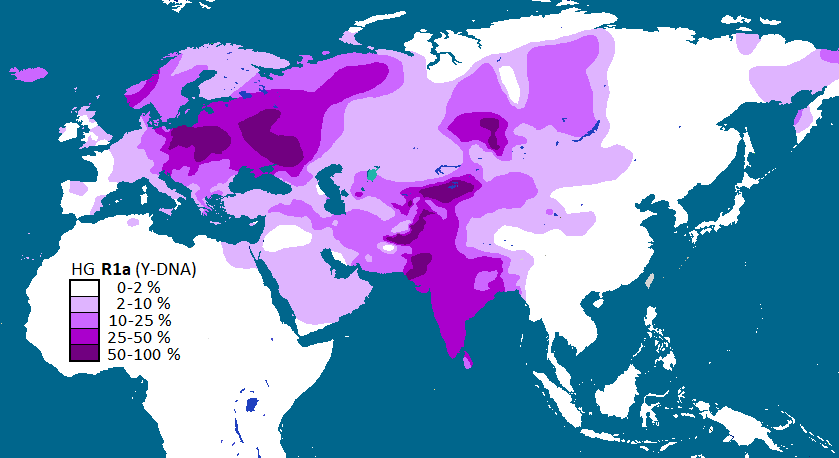Y-DNA haplogroup R1a

This haplogroup originated around 25000 BC to 22000 BC in the populations of Eastern European Hunter-Gatherers connected genetically to Ancient North Eurasians.
The earliest subclades R1a-Z645 and R1a-Z283 are associated with the Corded Ware Culture.
R1a-Z93 is associated with the Fatyanovo-Balanovo Culture and later with the Sintashta Culture and the Andronovo Culture that are ancestral to the Indo-Iranians.
R1a-M558 and R1a-Z92 are associated with the Indo-European Corded Ware Culture population in Estonia, Karelia and Finland.
R1a-M458 and R1a-Z280 are associated with the Slavic continuum in the Lusatian Culture of ancient Poland, Slovakia and Moravia[1]. Y-DNA haplogroup R1a-V2670 (R1a-CTS3402 from R1a-CTS1211/R1a-M558 and R1a-Z280) was already found in S9 burial dated to 2560 BC - 2290 BC from Somogyvár-Vinkovci Culture in West Hungary[2]. He carried the mtDNA K1a3a haplogroup[3]. As of 2022 AD most of men who carry the Y-DNA descendent from his haplogroup live in the Balto-Slavic countries (including Slovenia, Serbia and Bosnia; 172 people in Poland, 47 people in Ukraine, 304 people in Russia), Estonia (10 people), Southern Finland (20 people), Eastern Germany (26 people) and Hungary (25 people).
R1a-Z284 travelled to Scandinavia to give rise to the late Nordic Bronze Age.
92% (11 out of 12) of all the paternal lines of Tarim mummies' male remains surveyed as Y-DNA haplogroup R1a1a[4]. The other 1 belonged to the exceptionally rare paragroup K* (M9). The R1a1 lineage suggests a proximity of this population with Andronovo Culture related groups. Tarim mummies were also found to be genetically closer to the Andronovo Culture than to the Yamna Culture or Afanasevo Culture.
The R1a-M417 has been detected in the following percentages of all Y-DNA haplogroups in those populations:
- Kyrgyz: 63.5%
- Sorbians: 63%
- Russians (Oryol): 62.7%
- Poles: 60%
- Russians (Voronezh): 59.7%
- Belarusians: 50%
- Northern Indians: 48-72%
- Russians: 46%
- Lithuanians: 45%
- Pashtuns: 40-45%
- Ukrainians: 41.5%
- Latvians: 40%
- Estonians: 37%
- Norwegians: 31%
- Hungarians: 30%
- Tajiks: 30%
- Slovaks: 26%
- Icelanders: 24%
- Germans (Berlin): 22.3%
- Greeks (Thrace): 22%
- Greeks (North): 19%
- Uzbeks: 18%
- Iranians: 15%
- Kurds: 10%
- Finns: 10%
- Albanians: 9%
- Germans (West): 8%
- Greeks (South): 2%
- Irish: 0.5%
Map used in this article was created by Maulucioni and is shared on the CC 4.0 license.
Article created on the 9th of October 2018. New map by Maulucioni from Wikimedia Commons added on the 8th of January 2023.
